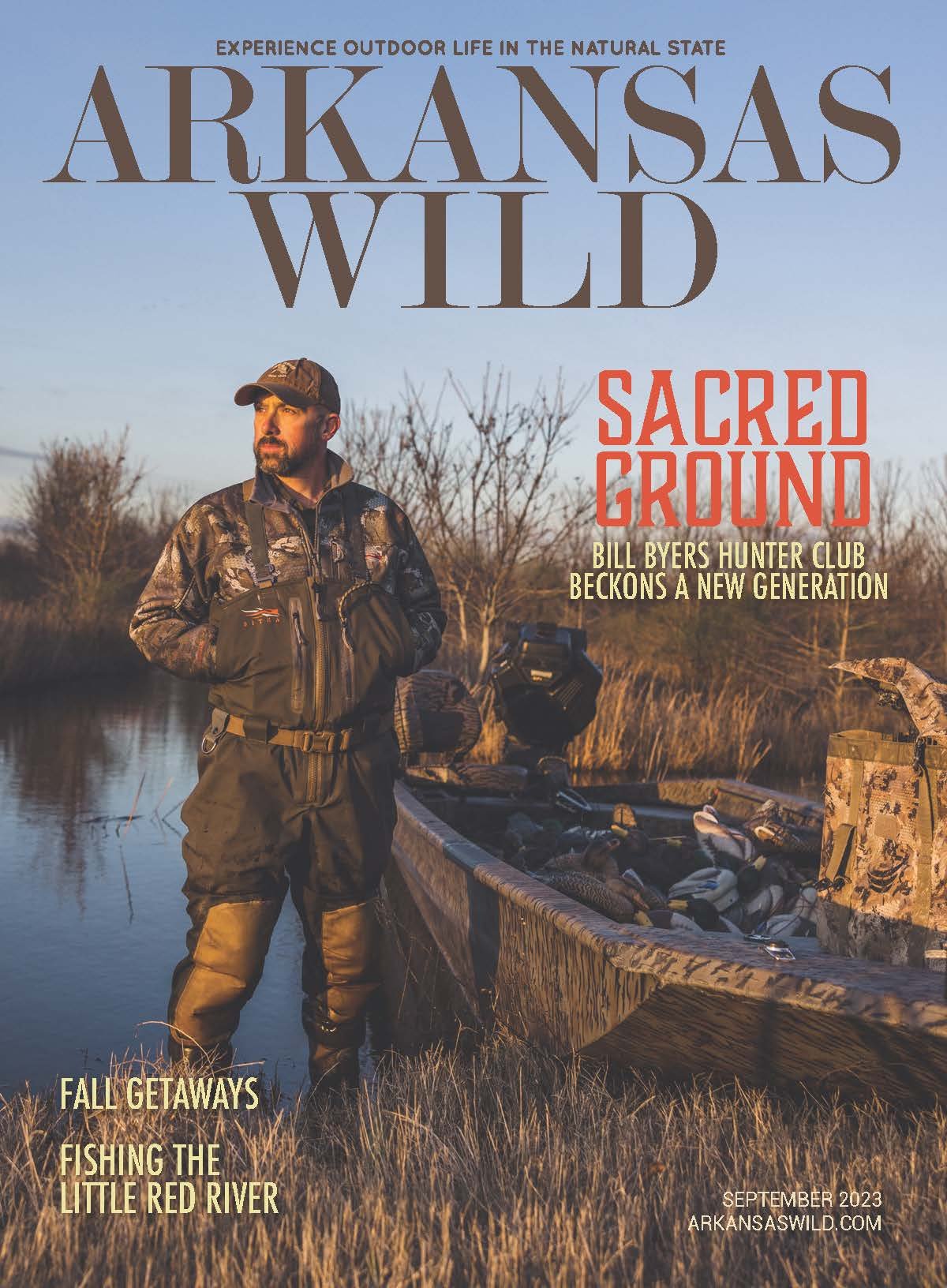Backpacking the Eagle Rock Loop Trail is a challenge and a wonder.
By Stephanie Smittle
Meet the Eagle Rock Loop, a 28.2-mile hike in the Ouachita National Forest. To call it a single trail is a bit misleading; it’s actually three trails — the Little Missouri, the Viles Branch Horse Trail and the Athens-Big Fork Trail. Those three paths meet to form a scenic and wildly varied circle that makes up the longest loop trail in Arkansas.
Expect to see a large contingent of out-of-state plates on cars at the various parking areas; this trail is stunning and the secret’s out. Winding Stairs is among the most beautiful spots in the Ouachitas — or the state, for that matter — and when the trail’s not intertwining with the Little Missouri River, it’s snaking through lush thickets on a canopied old horse trail or switch-backing up rocky mountaintops.
Your hike is your own, and you can do it however you want.
STAYING SAFE
Water crossings on the Eagle Rock Loop are, for much of the year, among your primary safety concerns. The Little Missouri River is no joke. Waters swell and recede rapidly, and after flash flooding in 2010 resulted in fatalities at the Albert Pike Campground, measures were taken to gauge water levels on the Little Missouri with increased vigilance. Check the U.S. Geological Survey’s real-time data at waterdata.usgs.gov/monitoring-location/07360200/ before you go; an impassable water crossing can make or break your hiking trip. Bring trekking poles, and avoid hiking when levels are above 4.5 feet.
LET’S TALK ABOUT MONEY
You can absolutely backpack in Arkansas without dropping hundreds of dollars — especially if you’re only planning on being out for a couple of nights and especially if you avoid the winter months. A couple of tips for keeping your backpacking budget in check:
Borrow gear shamelessly and liberally. Is there anyone in your circle of family or friends who spends a lot of time outdoors? You may well be able to borrow the bigger-ticket items you’ll need for a backpacking trip — a tent, a sleeping bag and a sleeping pad — so you can try before you buy.
If your outdated gear could use a refresh, Facebook groups like Backpacking Arkansas are great places to scout out opportunities for swapping used gear.
Wondering what you need? Check out the gear list in the sidebar or one of the myriad of great lists online; talk to the knowledgeable folks at Ozark Outdoor Supply; and always make sure you have the 10 Essentials.
Skip the dehydrated backpacking meals. A macronutrient-rich packet of Chicken Pho from Good To Go is going to be both tasty and convenient, but it’s definitely not your cheapest option. Plus, there’s no reason to buy an at-home dehydrator until you’re pretty sure backpacking is going to be something you do regularly.
Low-cost trail food like peanuts, oatmeal, chocolate, vacuum-packed tuna, red lentils (not brown, they take forever to cook), instant coffee and instant rice are easy to come by at the grocery store and make great outdoor meals. Pro tip: Check that kitchen drawer where all the forgotten takeout condiments live. Your unused packets of mayo, hot sauce, soy sauce, ketchup or Parmesan are perfect additions to a camp meal.
What you pack for Eagle Rock Loop depends on the time of year you go, whether you’re doing the whole loop or just a section and, of course, your level of experience and comfort.
HIKING THE LOOP
How best to approach the loop — clockwise or counterclockwise? From which starting point? — depends on who you ask. For my taste, hiking clockwise beginning at West Blaylock Creek (N34.381914 W093.961959 UTM 83) was the right way to go because it allowed me to split up the Athens-Big Fork section of the trail, so as not to slog through the toughest peaks on the trail in a single day.
Part of staying safe is knowing what your body can (and wants to) do on a hike. There’s a whole subculture of hiking vlogs and outdoor influencers who obsess over clockwatching their thru hikes, but it doesn’t mean you have to do likewise. I took every bit of three days to do a hike that some people whiz through in two or less, and I have zero regrets.
I took spurs to expansive vistas and then perched atop them for the better part of an hour. I sipped tea by rushing creeks. I stopped frequently on steep uphill climbs (I’m looking at you, Brush Heap Mountain). Most of all, I took my time. You can, too; your hike is your own, and you can do it however you want. If you’re a beginner and not sure what your hiking pace might be, get a good map and pick out a section to do overnight — the Little Missouri Falls trailhead to the Winding Stairs trailhead would be lovely.
CLOSING THE LOOP
Did you know you can (or could, at least, at the time this publication went to press) write off for a cool embroidered patch upon completion of the Eagle Rock Loop? Thanks to a donation from a Mr. Philip Strickhausen, you can call up the Caddo-Womble Ranger District’s office and ask that they send you proof positive that you hiked the loop. Slap it on your denim jacket so you can signal other people who have completed the trail and talk about how cool it is. (If you don’t have a denim jacket, what exactly are you waiting for?)
WHAT’S IN MY PACK
You’ll always and forever need the 10 Essentials, but outside of that, there’s room to customize. Here’s how I pack my 45-liter backpack for the 30-ish-mile trek:
THE 10 ESSENTIALS
Navigation — I bring a compass and map of the trail laminated at Kinko’s to protect it from rain
Headlamp (rechargeable or bring extra batteries)
Sun protection
First-aid kit; choose a backpacking-specific kit for items that help with blisters
Pocket knife
Shelter, such as a tent (with rain fly preferred) or hammock
A way to start a fire: I brought matches, a rechargeable electric lighter and fire starter chips
Extra water/water treatment
Season-appropriate clothing (remember, it gets colder than you think)
A day’s worth of extra food, just in case
WHAT ELSE I BROUGHT (10 Essentials, plus:)
Inflatable sleeping pad, inflatable pillow
30-degree sleeping bag (even in the summer!)
Pooping-in-the-woods sack: trowel, toilet paper
Kula cloth or “wilderness wipes”
Water filter (and treatment tablets as a backup)
Water reservoir for scooping up unfiltered water
Water bottle for filtered water
Food and critter-proof food canister
Toothbrush and a dab of toothpaste squeezed into a Ziploc
Notebook and tiny pencil
Bandana (also useful as a potholder)
Camp lantern plus extra batteries
Cookset: camp cup, fuel canister, backpacking stove, lightweight cooking pot, spork
Bug spray
Chapstick
Trash bag
Duct tape
Phone battery bank and charging cord
Sunglasses
Rain jacket
Spare pairs of socks/underwear
Fleece vest or windbreaker (yep, even in summer!)
Crocs for wearing at camp or crossing water
Emergency whistle
Bear spray (I’ll likely never use it in Arkansas, but I do know how.)
Car key, attached to a gear loop inside your bag so it doesn’t fall out
Driver’s license
Base layer clothing: lightweight pants, long-sleeved shirt
Foldable sun hat
Hiking boots










